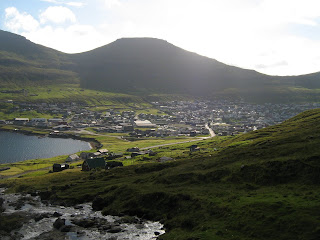And so we rang school and told them I'd be late, I grabbed my camera and rang the other kiwi here, Stacey, who we picked up from the swimming hall, and we headed down to the beach.
I want to explain the whaling before I put in photos of it, because it looks barbaric, but it's not. The Faroese have many reasons and justifications for their whaling, such as:
-the whales eat the cod and haddock around the Islands, which form the base of the Faroese fishing industry
-whale, or grind (pronounced grint) is a traditional source of food for the Faroese and has been since time immemorial. It is, however, more than this. It is also a practice deeply ingrained in their culture.
-the killing of whales is extremely humane. They are not harpooned, but their throats are cut on the shore. Each whale survives no longer than 15 seconds once it is beached.
-the whalings occur only when the whales come into the bay. They are not hunted, but rounded up, and only when they can be sighted from the shore. This can happen five times a year, or not at all.
-no profit is made from the whaling, but the meat is divided equally between the households represented on the shore at the time of the killing. A large book is put on a rock and names are entered into it and later, when the whales have been weighed and measured, their meat is divided to each family who requested a share.
It was a truly beautiful day today. The sky was clear of clouds and perfectly blue, the sun shone more strongly than I think I have seen it since I have been here. I was awoken at 5AM by the sunshine coming through my blinds.
The beach in Tórshavn is small, and as we walked down to it we could see that there were hundreds of whales (230 to be exact) laid out along the shore, and they were still bringing them in. A few were still being slaughtered - humanely with a great hook that sliced a wedge from the throat of the pilot whale, but most were already dead and being hauled in onto the beach. Each whale had ten or fifteen men on a rope, and some were waist deep, chest deep in the water which was bright, vivid red with blood. There were around a hundred boats all floating close to the shore. These had been the boats used to bring the whales into the bay.
When whales are first spotted, the call of 'grind' goes out across the entire city. Within ten or fifteen minutes, everyone knows that the whales have come to Tórshavn, because the call is shouted from house to house. Everything goes on word of mouth - indeed my host father found out about the whaling from our neighbours.
Many men, mostly those who own boats, head down to the shore to help. Many go out to help bring in the whales, others wait on the shore to slaughter them and bring them to the beach with their ropes. The boats surround the school and bring them in, just as one would round up sheep. They bring them closer and closer to the beach, until they can be tied with ropes and killed on the shore.
What I couldn't believe about the whaling was the audience. People go just to watch, and though it is fascinating for me, still a relative tourist, in terms of whaling anyway, I couldn't understand that it would be so astounding for the Faroe Islanders. It took me a long time to realise that it is because it is so much a part of their culture. Their parents, their grandparents, their forebears, have all butchered the whales, and so it is a very, very important tradition.
Once the whales are all killed and laid out on the shores, they tie them in groups of 2 or 3 to the boats remaining, which then tow them from the bay into the harbour. In the harbour they are lifted from the water with a huge crane and onto forklifts, which then transport them to a clean area where they are laid on the ground, measured and weighed. I was lucky enough to see the measurement of the whales, and they have a special system whereby they calculate how many househoulds can recieve meat from each whale.
In the evening, when the weighing and measuring is finished, another call goes out - this one of 'grindaboð', or whale message. They call all of the registered people into the middle of town to collect their allocated whale, and the town is a buzz of celebration and conversation. The days events are assessed and the whales are counted and divided. This is carried out by the police.
And that is the whaling, or grindaráp, as it is called in Føroyskt.

































